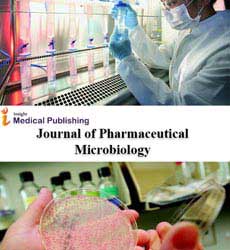Impact of Genetic Variation Influenced Enteric Fever
Maysaa EL Sayed Zaki*
Department of Infectious, Parasitic and Immune- Mediated Diseases, San Fransico
- *Corresponding Author:
- Maysaa EL Sayed Zaki Department of Infectious, Parasitic and Immune- Mediated Diseases, San Fransico, Email: maysaa.esz@yahoo.com
Received : December 08, 2021; Accepted : December 22, 2021; Published : December 29, 2021
Citation: Maysaa ESZ (2021) Impact of Genetic Variation Influenced Enteric Fever. J Pharm Microbiol Vol.7 No.2.e001
Enteric fever, an essential infection due to Salmonella typhi (S. typhi) and Salmonella paratyphi (S. paratyphi), is a primary tireless scientific hassle international, and is uncovered dominantly withinside the generating countries. The maximum not unusualplace risk elements are infected ingesting water or meals with defecation from both intensely infected persons, decided excretors, or incessant asymptomatic transporters, negative sanitation , negative cleanliness practices and coffee economic status. Approximately 22 million new instances of enteric fever with 200,000 instances of mortality have been registered international for every year. Enteric fever is likewise an crucial standard scientific hassle at the Indian subcontinent. S. Tiphi, S. Paratyphi are enteric fever related transcendent beings in India. Prompt and powerful antimicrobial remedy is the cornerstone of enteric fever management in blocking off lousy and mortal instances. The sickness might also additionally preserve for three months with out care, and the casualty stages may be as excessive as 30%, however with right remedy, medical manifestations die inside some days, fever subsides inside five days, and loss of life fees are decreased to < 1%.7 But the aimless use and ordinary antimicrobial abuse has ended in multidrug-secure lines being developed. The gift research become tried to decide the antimicrobial impotence (in view of MIC breakpoints) of chloramphenicol in opposition to different enemies of typhoid drugs (cefixime, ofloxacin, azithromycin, and ceftriaxone) in opposition to the type of Salmonella (counting S. typhi and S. paratyphi A) via way of means of E-take a look at. Positive S segregates of Blood culture. Tiphi, S. Paratyphi A (N=251) become examined for antimicrobial defenselessness via way of means of E-take a look at method at Metropolis Healthcare Limited (Mumbai, India) from 4 regions of India (North, South, West and East) among April and August 2018. According to Clinical and Laboratory Standards Institute measures 2018, the residing being become ordered as sensitive, transitional, and healthful in opposition to the separate anti-contamination dealers in mild of the bottom inhibitory fixation (MIC). Out of 251 Salmonella disengages, 192 (76. five%) have been S. typhi and 59 (23.five%) have been S. paratyphi A. all the 251 (100%) Salmonella secludes have been sensitive to cefixime, ceftriaxone, and azithromycin; 237/251 (ninety four. four%) confines to chloramphenicol and simply nine/251 (three.6%) disconnects have been sensitive to ofloxacin. In view of general MIC and MIC breakpoints, chloramphenicol (MIC: three.89±6.ninety four μg / mL), cefixime (MIC: 0.13±0.eleven μg / mL), azithromycin (MIC: three.32±2.19 μg / mL) and ceftriaxone have been deemed conscious of Salmonella disengage. (MIC: 0.eleven±0.18 μg/mL) and impervious to ofloxacin (MIC: 2.95±6.06 μg/mL). Over 20% of Salmonella confines had MICs of chloramphenicol as 1.five μg/ mL (27.85 taches) and multiple μg/mL. Considering converting styles of S.typhi and S.paratyphi anti-microbial vulnerability throughout exclusive topographical regions in India, constant reputation and ongoing reassessment of chloramphenicol remedy in Salmonella infection is crucial earlier than beginning remedy, to discourage in addition resistance development. This exam become consequently accomplished to research the instance of antimicrobial defenselessness of chloramphenicol and different enemies of typhoid drugs (cefixime, ofloxacin, azithromycin, and ceftriaxone) in opposition to Salmonella (counting S. typhi and S.paratyphi) obtained from 4 regions (north, south, west, and east) of India. In research, the diploma of S. Secludes of typhi have been numerous instances better than S. Paratyphi segregates (76.five percentage vs 23.five percentage) received over four months from blood samples. Various assessments had found out a better S-commonness. Typhoon over S. Paratyphi detachments received from enteric fever sufferers in blood checks. In any other research, sixty four Salmonella disconnects have been secluded from 840 suspected enteric fever blood checks wherein 41 (sixty four.1 according to cent) have been S. Typhi, and S.paratyphi isolates have been 23 (35.nine percentage).
Open Access Journals
- Aquaculture & Veterinary Science
- Chemistry & Chemical Sciences
- Clinical Sciences
- Engineering
- General Science
- Genetics & Molecular Biology
- Health Care & Nursing
- Immunology & Microbiology
- Materials Science
- Mathematics & Physics
- Medical Sciences
- Neurology & Psychiatry
- Oncology & Cancer Science
- Pharmaceutical Sciences
